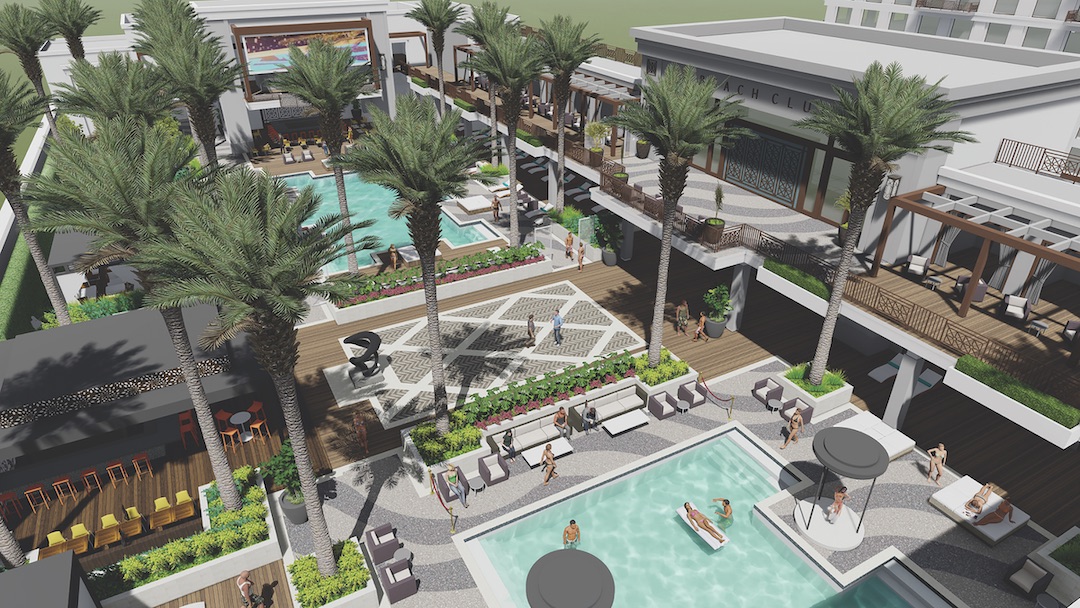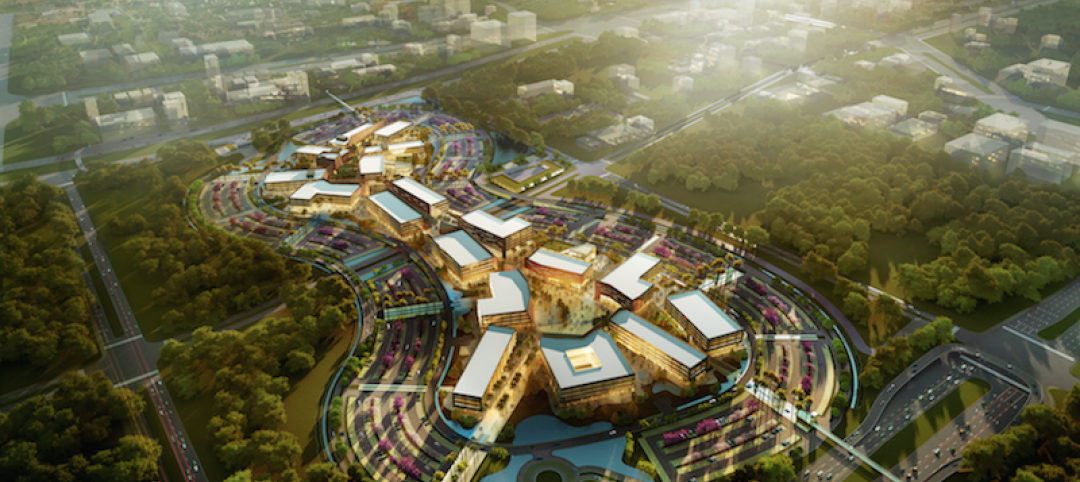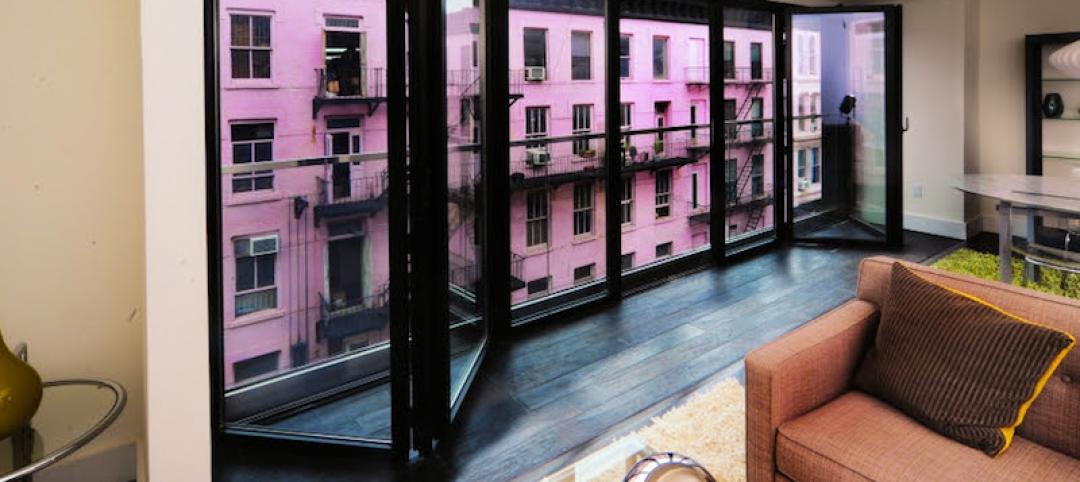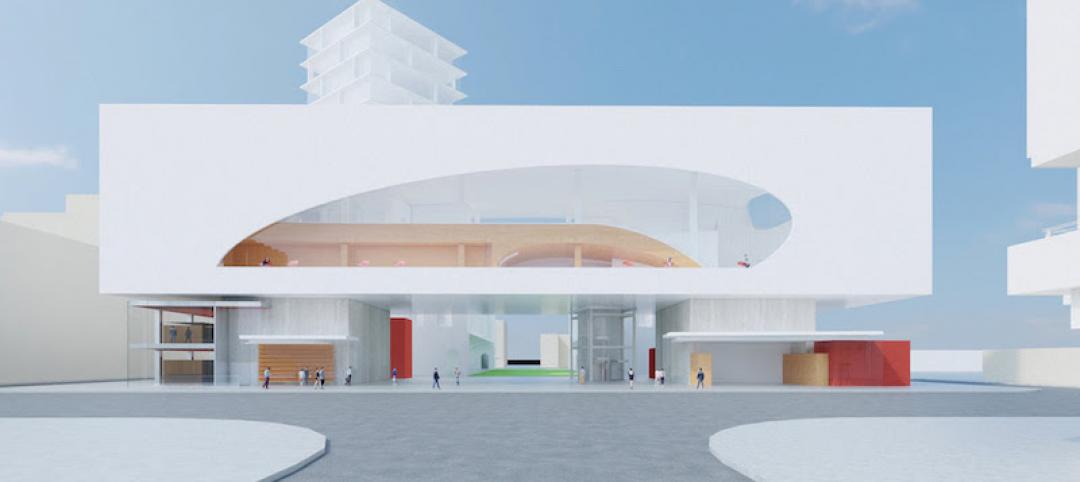During the early months of 2020, construction is scheduled to start in Irvine, Calif., on BANC, a 250-key luxury hotel with 16 condos and 150,000 sf of office space. Sitting atop that building’s parking garage will be a 40,000-sf roof deck with two swimming pools, a 6,500-sf nightclub, and $1.4 million in landscaping.
The landscaping will contribute to providing a level of intimacy for an amenity that accommodates 1,200 people. Another element meant to create “a kind of Las Vegas experience” will be 40 rentable cabanas, including six that fit up to 20 people each, says Rob Budetti, NCARB, CDP, LEED GA, Partner with AO Architects, this project’s designer.
BANC accentuates how roof deck entertainment spaces have become prevalent, even essential, in new construction and as additions to existing buildings. The amenity has become a prominent feature for office buildings, offering “an accessible, secure extension of the occupants’ workplace,” explains John Crump, Vice President and Workplace Studio Leader for SmithGroup’s Washington, D.C., office, whose recent projects include the District Center at 555 12th Street NW, with a 10,000-sf outdoor terrace.
When considering a roof entertainment space, project teams must address several factors: weight loads, moisture control and rainwater management, wind uplift, and occupant safety. The BANC project, for example, must account for the pools’ depth (3½ to 4 feet) and planters with six feet of planting depth, says Diego Alessi, ASLA, Principal and Director of AO Architects’ landscape studio.
There are four types of loads—snow, rain, live, and dead—that any roof deck design manages, says Blair Hildahl, PE, LEED AP, CMO and Founding Partner with Base4, an AE firm based in LaCrosse, Wis. He adds that if shear walls don’t extend above the roof level, the rooftop structure must be able to withstand lateral loads from seismic and wind activity.
“Planning for a roof deck needs to happen at the concept stage,” says Hildahl. “The challenge is to make egress, accessibility, insulation requirements, and waterproofing/drainage work together efficiently.”
That gets complicated when the amenity is being dropped onto an older building whose original structural design only figured on snow and dead loads on the roof.
Chicago-based architecture and construction firm Epstein designed the conversion of the Conrad Chicago from an office building to a hotel. The owner, Lawrence Geller, insisted on adding a dynamic roof, so Epstein had to make sure the building’s columns could handle the extra load. The columns were reinforced with a carbon-fiber spray, and beams were installed under the roof slab, says David Scott, AIA, Epstein’s Director of Hospitality.
Roof deck amenities are typically built in layers, and the lower layers “are probably not going to be touched again for a very long time,” says Craig Hargrove, AIA, LEED AP, CDT, RRC, Senior Vice President and Director of Architecture with Hoffmann Architects. “So how those layers get built is important because they can be fabulously expensive.”

Hargrove notes that a deck must deal with the pitch that funnels rainwater from the roof to drains. But a ½-inch incline in the walking surface “can be noticeable and disturbing psychologically” to people standing on it.
Water can be moved to drains at two levels: at the structural deck where the waterproofing membrane is often installed, and above the deck at the walking surface. If these two surfaces drain independently, each can have two different pitches, allowing the walking surface to have a slope that is more conducive to the use of the space. In other cases, such as with loose laid pavers on a pedestal system over the structural deck, the walking surface can be level with no pitch, because water that might collect at the walking surface will drain to the structural deck between the pavers. The pitch of the roof then moves the water by gravity to the drains.
Another approach—and one that is typically less expensive—is to stack high-density plastic adjustable shims, known as screw jacks, under the corners of the deck to level the panels.
In any reconstruction that involves a roof deck, “it’s important to consider insulation placement,” advises Carl Baldassarra, Principal and Unit Manager with Wiss, Janney, Elstner Associates (WJE). Improper installation below the roof deck can lead to problems such as increased freeze-thaw damage, efflorescence, and condensation.
To control moisture, WJE uses a separate waterproofing membrane, such as hot applied rubberized asphalt, which functions as an air barrier and vapor retarder on the surface of the deck, say WJE Principals Norbert Krogstad and Rich Koziol. (The choice of insulation, says Koziol, is currently confined to extruded polystyrene board because of its water-resistant properties.)
Hargrove of Hoffmann Architects notes that the trick is to keep the roof’s membrane as far away from the asset as possible to protect the membrane, which is a key component in moisture control. Penetration points therefore should be flashed and detailed carefully.
 The roof deck amenity atop the Conrad by Hilton hotel in Chicago—an adaptive reuse of an office building—required that the building’s structural columns be reinforced to hold the extra weight. Roof deck amenities must also handle wind lift when installing flooring and furniture. Photo: Neal Burger/courtesy Epstein.
The roof deck amenity atop the Conrad by Hilton hotel in Chicago—an adaptive reuse of an office building—required that the building’s structural columns be reinforced to hold the extra weight. Roof deck amenities must also handle wind lift when installing flooring and furniture. Photo: Neal Burger/courtesy Epstein.
Getting the entertainment space to intersect seamlessly with the roof’s rainwater drainage system is a design imperative. But, Scott cautions, “People don’t want to see what you’re doing to remove water.”
To manage rainwater, BANC’s roof deck amenity will be built on paving materials atop a pedestal-like system that, at different areas, will be between six and 18 inches above the roof. Irrigation and drainage will go through the underdeck space. Planters will have their own drainage system that’s filtered through a biofiltration swale (a requirement in California).
Wind can play havoc on outdoor entertainment spaces. WJE’s Krogstad says that, depending on the space and the height of the building, it might be necessary to anchor the deck or terrace finishes to the structure below. Hargrove points out that manufacturers offer paver-locking systems, in wood or precast concrete, so that the roof itself acts as a large unit of ballast.
See Also: Passive House picks up steam
Base4’s Hildahl notes that the deck height can affect the elevator landing heights. “And if there’s a kitchen or any covered spaces, they need to be raised, too; otherwise you may need a ramp for such spaces.”
The number of exit doors, stairs, sprinklers, standpipes, and elevators that a roof deck entertainment space must have is spelled out in codes that, for an existing building, sometimes lead to reconstruction. “It’s sort of the reverse from the way most buildings are designed” because people are moving back and forth from the top of the building, says Epstein’s Scott. For the Conrad Chicago project, the Building Team had to deconstruct a section of the building to make way for a second stairwell.
In the interest of occupant safety, rooftop spaces used by the public need to be reviewed for guardrail height, says WJE’s Baldassarra. Roof decks on tall buildings might also limit the use of combustible materials such as wood decking.
Related Stories
High-rise Construction | Oct 4, 2017
90-story mixed-use building could become Denver’s first supertall tower
Manhattan-based Greenwich Realty Capital is developing the project.
Reconstruction & Renovation | Sep 28, 2017
Plans for Chicago’s historic Post Office building revealed by 601W Companies and Gensler
The redevelopment project is currently the largest in the nation.
Mixed-Use | Sep 26, 2017
Perkins+Will designs new international business community in Cali, Colombia
The new free trade zone is designed to resemble a small village.
Mixed-Use | Sep 25, 2017
Getting there is half the fun: Mass transit helps entertainment districts thrive
In Los Angeles, the entertainment district L.A. Live is expected to benefit from the proposed expansion of the city’s mass transit system.
Mixed-Use | Sep 25, 2017
One of L.A.’s most sought-after neighborhoods receives a new mixed-use development
The new development will feature 166 units and 9,000 sf of ground-floor retail.
Mixed-Use | Sep 22, 2017
Defending against the online dragon
Some entertainment districts are going light on retail, partly because “the bulk of the leasing demand is for dining and entertainment,” say Barry Hand, a Principal with design mega-firm Gensler in Dallas.
Mixed-Use | Sep 21, 2017
Entire living rooms become balconies in a new Lower East Side mixed-used development
NanaWall panels add a unique dimension to condos at 60 Orchard Street in New York City.
Mixed-Use | Sep 18, 2017
Urban heartbeat: Entertainment districts are rejuvenating cities and spurring economic growth
Entertainment districts are being planned or are popping up all over the country.
Mixed-Use | Sep 14, 2017
Capital One eschews the traditional bank with the Capital One Café
The new branch in downtown Santa Monica offers 8,400 sf of space designed by Gwynne Pugh Urban Studio.
Libraries | Sep 1, 2017
Johnson Favaro selected to design new main library in Riverside, Calif.
The choice comes after a 12-year planning process and a yearlong selection process.

















